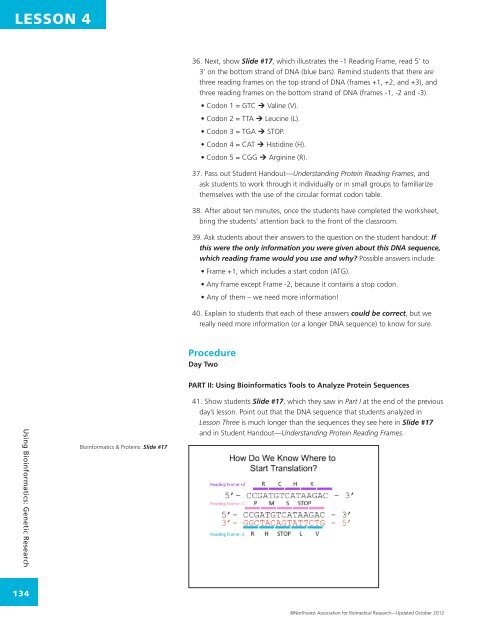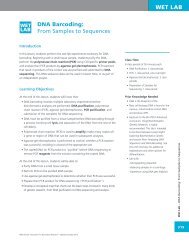LESSON 4 Using Bioinformatics to Analyze Protein Sequences
LESSON 4 Using Bioinformatics to Analyze Protein Sequences
LESSON 4 Using Bioinformatics to Analyze Protein Sequences
You also want an ePaper? Increase the reach of your titles
YUMPU automatically turns print PDFs into web optimized ePapers that Google loves.
<strong>LESSON</strong> 436. Next, show Slide #17, which illustrates the -1 Reading Frame, read 5’ <strong>to</strong>3’ on the bot<strong>to</strong>m strand of DNA (blue bars). Remind students that there arethree reading frames on the <strong>to</strong>p strand of DNA (frames +1, +2, and +3), andthree reading frames on the bot<strong>to</strong>m strand of DNA (frames -1, -2 and -3).• Codon 1 = GTC Ú Valine (V).• Codon 2 = TTA Ú Leucine (L).• Codon 3 = TGA Ú STOP.• Codon 4 = CAT Ú Histidine (H).• Codon 5 = CGG Ú Arginine (R).37. Pass out Student Handout—Understanding <strong>Protein</strong> Reading Frames, andask students <strong>to</strong> work through it individually or in small groups <strong>to</strong> familiarizethemselves with the use of the circular format codon table.38. After about ten minutes, once the students have completed the worksheet,bring the students’ attention back <strong>to</strong> the front of the classroom.39. Ask students about their answers <strong>to</strong> the question on the student handout: Ifthis were the only information you were given about this DNA sequence,which reading frame would you use and why? Possible answers include:• Frame +1, which includes a start codon (ATG).• Any frame except Frame -2, because it contains a s<strong>to</strong>p codon.• Any of them – we need more information!40. Explain <strong>to</strong> students that each of these answers could be correct, but wereally need more information (or a longer DNA sequence) <strong>to</strong> know for sure.ProcedureDay TwoPART II: <strong>Using</strong> <strong>Bioinformatics</strong> Tools <strong>to</strong> <strong>Analyze</strong> <strong>Protein</strong> <strong>Sequences</strong><strong>Using</strong> <strong>Bioinformatics</strong>: Genetic Research<strong>Bioinformatics</strong> & <strong>Protein</strong>s: Slide #1741. Show students Slide #17, which they saw in Part I at the end of the previousday’s lesson. Point out that the DNA sequence that students analyzed inLesson Three is much longer than the sequences they see here in Slide #17and in Student Handout—Understanding <strong>Protein</strong> Reading Frames.134©Northwest Association for Biomedical Research—Updated Oc<strong>to</strong>ber 2012
















